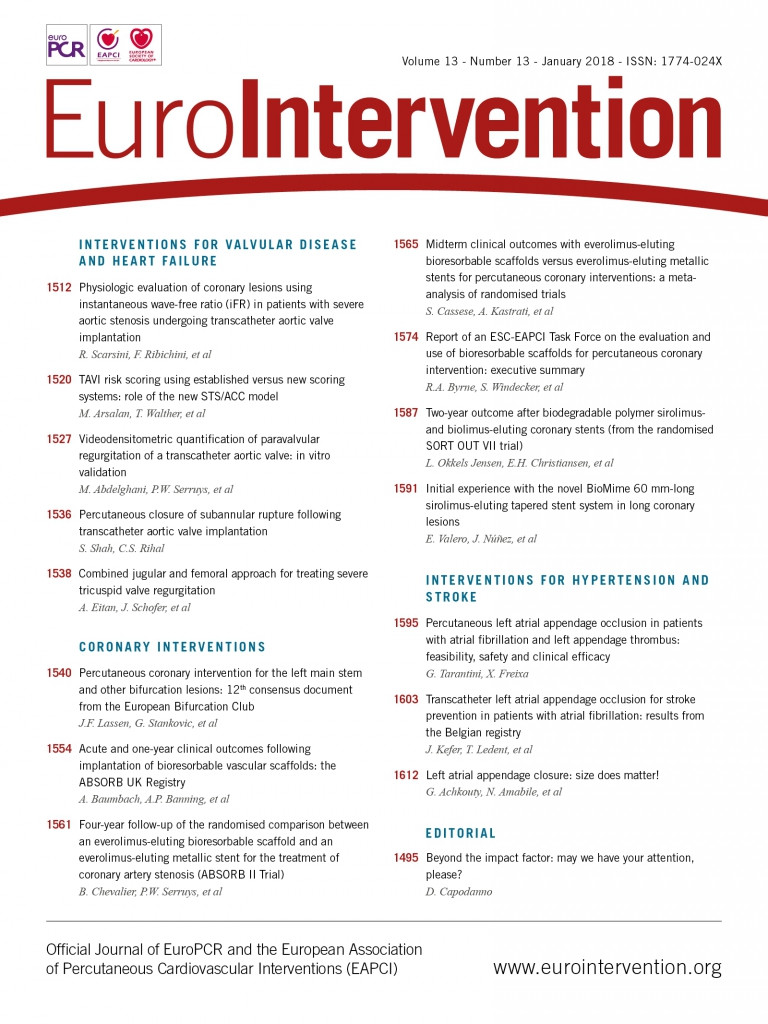
Too much talking about the impact factor (IF) might not be elegant for a scientific journal as it sounds self-referencing. The IF is a number that many criticise but – let’s be clear – as many look at. This year, EuroIntervention was blessed by a substantial increase in its IF and the most tangible effect of this improvement was an intensification in paper submissions during the last couple of months, which has led the Editorial Board to reduce the acceptance rate. Without going into boring numbers, these two simple metrics (IF, acceptance rate) tell us that the Journal is in good shape.
Obviously, from the Editors’ perspective, the IF is an important prerequisite to attract high-quality submissions. From the authors’ perspective, publishing in high-IF journals is rewarding and has notable academic implications, but I think you will agree that the ultimate goals of publishing original research are first to advance science and second to make this effort visible and useful to as many readers as possible. Over the years, EuroIntervention has worked in many ways to increase the reach of its accepted articles, from the introduction of expedited electronic publication (EEP) to e-blast campaigns reaching thousands of readers worldwide, from the creation of the “ahead of print” section of the website to the “push” of selected contents through dedicated social media channels.
Benefits to the authors who choose EuroIntervention to publish their original research now include a new tool called Altmetric. According to the developers, Altmetric collects “metrics and qualitative data that are complementary to traditional, citation-based metrics”. In other words, every time an article is cited outside the usual scientific channels (e.g., another article) Altmetric counts a score. When I speak of non-traditional channels, I refer to anything: a blog, mainstream media, an online reference manager, Wikipedia, Facebook, Twitter, Google+, LinkedIn, YouTube, and so on and so forth. The result (“attention score”) is expressed in the shape of a “donut”, with different colours representing a different source of attention (“the amount of each colour in the donut will change depending on the sources from which a research output has received attention”). You may already have noticed such donuts or tags in the “current issue” and “ahead of print” pages of the EuroIntervention website. Our ambition is to make this information more and more visible at the article page level. By clicking on the Altmetric’s donut or tag, any reader or author may visit the details page for the research output and read the original mentions and references that have contributed to the attention score.
In some ways, the IF captures the interest of academics, while the attention score captures the interest of the general reader. At this point, one might wonder what an attention score adds to what we already know about the readers from other sources. For example, for years the EuroIntervention website has reported, in a special box, the ranking for downloads per article (to tell the truth, only the first three positions). With such information available, you might already have an idea of the topics that are appreciated most. For example, at the time of writing this Editorial, the two most downloaded papers are 1) the article, already published ahead of print and now printed in this issue, summarising the output of the 12th European Bifurcation Club meeting1, and 2) a review article on the prerequisites for a successful transfemoral TAVI procedure2. I always assumed that this kind of information was enough to understand our readers’ interests, until I had the chance to take a look at the Altmetric statistics of EuroIntervention.
Analysing the results sorted by the attention score, we learned that there has been a steep increase in mentions over the last two years (Figure 1), which clearly reflects the boom of social media interactions. The most important contributing source of mentions for EuroIntervention is Twitter (91%), followed by Facebook (7%). While some contents are selected and pushed on Twitter by the Editorial Office on a daily basis, the absolute numbers tell us that the articles generate spontaneous advertising in the form of retweets, or discussion in the form of short comments (Twitter has recently relaxed the 140-character maximum rule to allow a new maximum of 280 characters). Interestingly, the most mentioned articles from EuroIntervention (based on Altmetric’s criteria) are not necessarily the most cited ones (based on IF criteria). The most tweeted or retweeted item so far, for example, is an article from Secco et al published in June 2016 on a very high-pressure balloon catheter for undilatable coronary lesions3. Other articles in the current top ten deal with emerging technologies (e.g., pressure-controlled intermittent coronary sinus occlusion4, a self-expanding stent5, a renal protection device6), and daily practice (e.g., drug-eluting stents in bifurcations7, a new approach for radial access8). Perspectives9 and editorials10-12 also appear to be very popular formats, with mentions coming not only from tweets but also from news outlets.

Figure 1. Results for articles, data sets, clinical trial records, and news stories sorted by Altmetric Attention Score with keywords containing “EuroIntervention” (from January 2012 to December 2017).
Obviously, there is room for improving these statistics and the quality of the mentions, but the trend seems well discernible. Overall, the Altmetric information corroborates in a more granular fashion what we already suspected from the ranking of top downloads, implying that the Journal is more successful in addressing the needs of its readership (or at least of the web community sample) when the articles deal with innovation and everyday practice. Addressing the needs of the readership has been the mission of the Journal since its inception and the Editorial Board is very respectful of that history. Articles dealing with innovation and daily practice are what the greatest part of the interventional community is more prone to share or react to. But are these articles what the academic community of authors will cite? There are physicians using the Journal to stay in line with the evolution of the field, academics using the Journal to shape some parts of their papers, and people doing both. Can we address all these needs simultaneously or are some of them incompatible? These are crucial questions for us from a strategic standpoint, but the answer is clear: we aim to offer the highest possible IF to our authors, but building a journal that attracts the attention of the practising physicians remains our top priority. Finding the best blend for EuroIntervention, at the intersection between science and practice, is an enduring, stimulating challenge. We count on your feedback to maximise our chances of success in this endeavour.

